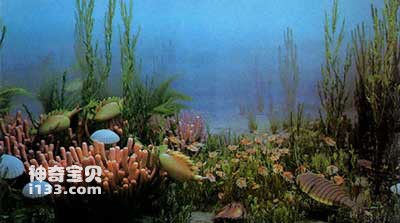Between 430 and 345 million years ago, intense orogeny occurred in the earth's crust. The sea surface shrank, land appeared widely, and the climate became dry and hot.

Cretaceous marine biomes
During the ebb and flow of sea water, some algae slowly adapt to life on land. They lie in the mud, without roots and with upright stems. It has no leaves and is called a light fern. It was their struggle against the strong winds and drought on land and their tenacious adaptation that finally gave the earth its first green coat. After the naked fern, pioneered by the light fern, successfully landed on land, the prelude to the great prosperity of ferns began.
During this period, a very important event occurred in the aquarium; in the waters along the southeastern coast of my country, a small animal with a translucent body still lives. Because it was first discovered in Wenchang County, my country, it is called amphioxus. Darwin once called this "the greatest discovery" because it "provided the key to revealing vertebrates."

Amphioxus
Amphioxus is not a real fish. It has no backbone and only has a notochord running through the body as a pillar to support the body. This pillar represents the forerunner of the spine. animals that developed after it. Like fish, birds, and beasts. So much so that humans are all vertebrates. The organs and functions of these vertebrates vary widely, but the structure of the spine is basically the same.
On the basis of amphioxus, fish evolved. Fish have a backbone (vertebral column) that truly supports the body. Buried on the back of the spine is a soft spinal cord and a brain that evolved to expand forward. This newly formed highly developed nerve center makes animals unprecedentedly smart. Fish, with fins and tail. The whole body becomes streamlined and can swim around. They became the most advanced animals on earth at that time. Their descendants soon occupied all the rivers, lakes and seas. The next 50 million years can be called the Age of Fish.
Some of the fish living in today's rivers, lakes and seas, such as sturgeons, sturgeons, carp, crucian carp, sharks, rays, rays, etc., are their direct descendants, and some are their close relatives. How do fish get from water to land? What kind of fish was the earliest pioneer to land? A strange fish fossil was discovered in the stratigraphic fossils about 300 million years ago - lobofin fish. The lobe fish has two major characteristics: first, the arrangement of its pectoral and pelvic fin bones is basically the same as the limb bones of modern living frogs. These powerful fins facilitate supporting and moving the body on land; second, the lobe fin Fish can breathe air directly using their swim bladders.
More than 300 million years ago, the climate was warm. In some areas, due to plant decay and lack of oxygen in the water, it was not suitable for fish to live in. During droughts, thousands of fish die alive. The drought forced the fish to crawl from one pond to another. Zong Shaoyu, who originally wanted to find water, may now discover what a wonderful world the land is!
After Euglena landed and took root, the first batch of huge terrestrial plants slowly grew, forming a large swamp forest.
This strange world is very tempting to lobe fish, which are not good swimmers. They finally stayed on land where they breathed fresh air. There was food to eat there, and there were no enemies to harm them, so from generation to generation, the thorax and abdomen became limbs, the gills degenerated, the swim bladder turned into lungs, and finally a new group was formed - amphibians. kind.
The patriarch of modern amphibians is the caecilian. The largest existing amphibian in the world is the giant salamander (salamfish), a specialty of my country. The most diverse groups of amphibians are frogs and toads, which have always lived happily until now.
animal tags:
We created this article in conjunction with AI technology, then made sure it was fact-checked and edited by a Animals Top editor.